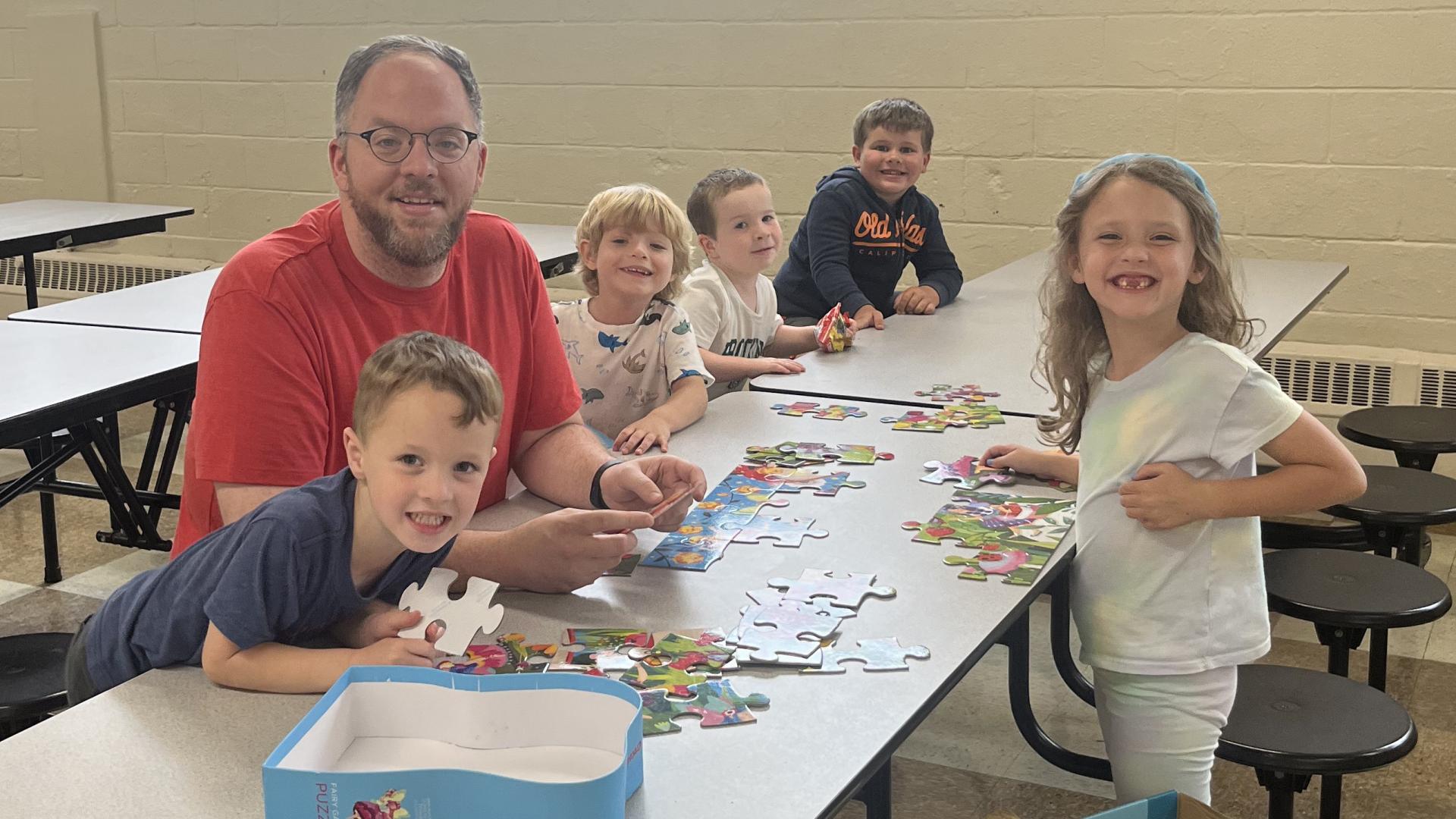“I’ll probably forget what he taught me about the civil war at some point, but I’ll never forget how he treated me as a person, and I think that’s the most important thing we can give to our kids at a Catholic school.”
Eric Harper’s high school history teacher likely didn’t realize the impact he was making on the future educator, but his compassionate instruction became a puzzle piece that fit into other moments and memories to reveal Harper’s vision for Catholic education. He has brought this vision to life along his journey from teacher to principal, earning him the 2025 Michael Pressley Award for Excellence in Catholic Education.
Two awards are given annually to ACE graduates who have distinguished themselves in making significant contributions to the ministry of Catholic education. In addition to Harper, Emily Lazor-Rodgers (ACE 18), a current teacher at Cristo Rey Dallas College Prep, has been named a Michael Pressley award winner this year.
Harper first felt drawn to the educational field as a high school student in Chicago. He dipped his toes into teaching through summer programs, where ACE alumni nudged him to look into ACE Teaching Fellows. After a college degree in political science, Harper decided to take the plunge and commit to ACE 20.
“I didn’t know what I was signing up for,” he chuckled when reflecting.
The First Piece
Any amateur puzzler knows that it is advantageous to set the corners first, and it was during ACE summer that Harper set the first corner of his educational puzzle. Harper had fallen away from his faith in college, believing that Catholicism lacked joy, life, and vibrance. He had only experienced “vinegar-faced Catholics” as described by Pope Francis – those whose devotion forgot smiles.
“ACE was the first time I saw people who had a smile on their face sharing in the mission of being Catholic – it was something about 90 vibrant twenty-two year olds that were like ‘I’m Catholic and I’m proud of it’ that was so enticing to me.”
This display of joy tugged Harper back into his faith, setting vibrant Catholicism as the first corner of his educational puzzle. This corner directed the way that every following piece fell into place.
The Second Corner
 Harper moved to his ACE placement of Memphis, Tennessee as a social studies teacher at Memphis Catholic Middle and High School. Within the first few weeks, he realized one fundamental aspect of teaching.
Harper moved to his ACE placement of Memphis, Tennessee as a social studies teacher at Memphis Catholic Middle and High School. Within the first few weeks, he realized one fundamental aspect of teaching.
“You spend a lot of your summer planning your syllabus and then you get to your placement, and you realize that those kids don’t really care about your syllabus -
They care that you care about them.”
For Harper, the rigor of education fell second to the bond between educator and student; learning required a relationship first. He spent the next six years -- two in the program and four after -- at Memphis Catholic filling in pieces between the two corners by practicing a vibrantly Catholic and relationship-focused education with his “just weird enough” middle schoolers.
In 2019, Harper followed a prompting from one of his ACE content professors to teach at Saint Mary’s Mission School in Red Lake, MN. Saint Mary’s is a part of the American Indian Catholic Schools Network (AICSN). AICSN strives to create a foundation of mutual leadership that encourages and supports each of the schools in its ministry, while strengthening their collective ability to facilitate collaboration, provide professional development opportunities, and conduct research. Harper felt called to Saint Mary’s and entered what he considered to be the “most challenging teaching experience of [his] life”. Although Harper cherished his time there, he ended many days depleted and took solace in advice from his pastor.
“Go home, let out your emotions, and then just go back the next day knowing that you have the power to change a life."
The Third Corner
Discipline can be the trickiest component of education, as its implementation can make or break a student’s educational career. Harper’s principal at Saint Mary’s understood this intimately. He saw discipline as a matter of mending relationships; behavioral outbursts weren’t seen as ‘breaking the rules’ but rather damaging the relationship between teacher and student. He gave consequences as avenues of repair, not as punishments. To aid students in understanding their role in the dynamic, the principal placed the onus of repair on the student.
“Well, what are you going to do to restore this relationship?”
 This philosophy stuck with Harper as he transitioned from teacher to leader when he left Saint Mary’s to take on the role of principal at Our Lady of Grace in the Archdiocese of Philadelphia. He set this philosophy as the third corner of his puzzle and filled in new pieces by reflecting on and refining his answer to the question, “How does consequence interact with Christianity?” His discipline policy stemmed from the realization:
This philosophy stuck with Harper as he transitioned from teacher to leader when he left Saint Mary’s to take on the role of principal at Our Lady of Grace in the Archdiocese of Philadelphia. He set this philosophy as the third corner of his puzzle and filled in new pieces by reflecting on and refining his answer to the question, “How does consequence interact with Christianity?” His discipline policy stemmed from the realization:
“Misbehavior ruins your relationship with your teacher the same way that sin ruins our relationship with God. But, God gives us a pathway to restoring our relationship with Him when we sin, so why are we not giving a student that same pathway?”
Harper now leads his school by intentionally providing that pathway for his students. Discipline has a clear purpose not just to his staff but to his students, and students are able to recognize the effects their actions might have on the whole community.
The Fourth Corner
Throughout his four years as a principal at Our Lady of Grace, Harper found his fourth and final corner in his favorite aspect of the job – being with his students.
“I love when Pope Francis said that a good pastor smells of the sheep, and I think a good principal smells of the sheep, too.”
This final corner completes the image of relationships started by its diagonal sister. As Harper identified previously, learning requires a relationship. To build this relationship, one must integrate themselves into the lives and daily structures of the community. Harper says his favorite way to do this is through lunchroom duty. He enjoys popping from table to table, taking a few minutes to sit with students and get to know them beyond their possibly more polished classroom demeanors.
Harper’s four corners of vibrant Catholicism, relationships before learning, reparatory discipline, and smelling of the sheep have formed the outline of his vision for Catholic Education. Throughout his career, this outline has filled in with experiences and realizations that have formed a rich and vivid image of the purpose for Catholic schools in the world.
Harper is eager to share his vision with the pastor at St. Matthias in New Jersey where he was recently appointed principal. He will begin his move from Philadelphia to New Jersey this summer, leaving behind an impressively large hole at Our Lady of Grace.
Harper dedicates so much of his life and passion to Catholic education that it seems impossible he almost left his puzzle in the box. But, as St. Augustine says, “joy is the net of love by which you can catch souls," and the smiles of ACE 20 provided the ropes.
 Alliance for Catholic Education
Alliance for Catholic Education
